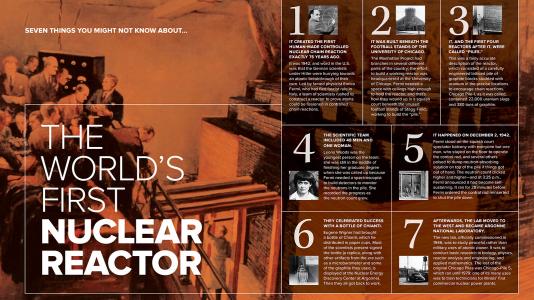7 things you might not know about the world’s first nuclear reactor

1. It created the first human-made controlled nuclear chain reaction exactly 75 years ago.
It was 1942, and word in the U.S. was that the German scientists under Hitler were hurrying towards an atomic breakthrough of their own. Led by famed physicist Enrico Fermi, who had fled fascist rule in Italy, a team of scientists rushed to construct a reactor to prove atoms could be fissioned in controlled chain reactions.
2. It was built beneath the football stands of the University of Chicago.
The Manhattan Project had branches in several different parts of the country; the effort to build a working reactor was headquartered at the University of Chicago. Fermi needed a space with ceilings high enough to hold the reactor: and that’s how they wound up in a squash court beneath the unused football stands of Stagg Field, working to build the “pile.”
3. It, and the first four reactors after it, were called “piles.”
This was a fairly accurate description of the reactor, which consisted of a carefully engineered latticed pile of graphite blocks studded with uranium in the precise locations to encourage chain reactions. Chicago Pile-1, as it was called, contained 22,000 uranium slugs and 380 tons of graphite.
4. The scientific team included 48 men and one woman.
Leona Woods was the youngest person on the team; she was still in the middle of finishing her graduate degree when she was called up because Fermi needed a spectroscopist to build detectors to monitor the neutrons in the pile. She recorded the progress as the neutron count grew.
5. It happened on December 2, 1942.
Fermi stood on the squash court spectator balcony with everyone but one man, who stayed on the floor to operate the control rod, and several others poised to dump neutron-absorbing solution on top of the pile if things got out of hand. The neutron count clicked higher and higher—and at 3:25 p.m., Fermi announced it had become self-sustaining. It ran for 28 minutes before Fermi ordered the control rod reinserted to shut the pile down.
6. They celebrated success with a bottle of Chianti.
Eugene Wigner had brought a bottle of Chianti, which he distributed in paper cups. Most of the scientists present signed the bottle (a replica, along with other artifacts from the era such as a microbarometer and some of the graphite used in CP-1, is displayed at the Nuclear Energy Discovery Center at Argonne). Then they all got back to work.
7. Afterwards, the lab moved to the west and became Argonne National Laboratory.
The new lab, officially commissioned in 1946, was to study peaceful rather than military uses of atomic power. It was to conduct basic research in biology, physics, reactor analysis and engineering, and applied mathematics. The last of the original Chicago Piles was Chicago-Pile 5, which ran until 1979; one of its many uses was to train technicians for Illinois’ first commercial nuclear power plants.
Find more information about early reactors and Argonne’s work on them at the Nuclear Engineering division’s website.
Argonne National Laboratory seeks solutions to pressing national problems in science and technology. The nation’s first national laboratory, Argonne conducts leading-edge basic and applied scientific research in virtually every scientific discipline. Argonne researchers work closely with researchers from hundreds of companies, universities, and federal, state and municipal agencies to help them solve their specific problems, advance America’s scientific leadership and prepare the nation for a better future. With employees from more than 60 nations, Argonne is managed by UChicago Argonne, LLC for the U.S. Department of Energy’s Office of Science.
The U.S. Department of Energy’s Office of Science is the single largest supporter of basic research in the physical sciences in the United States and is working to address some of the most pressing challenges of our time. For more information, visit the Office of Science website.
